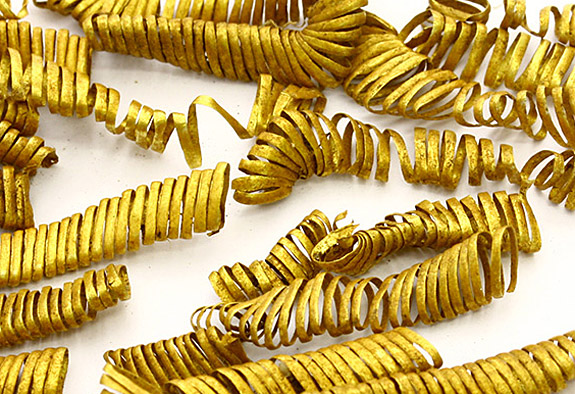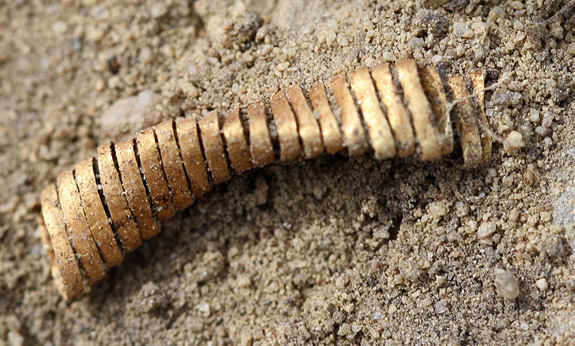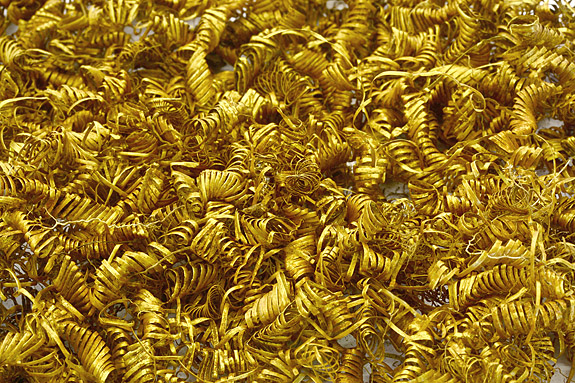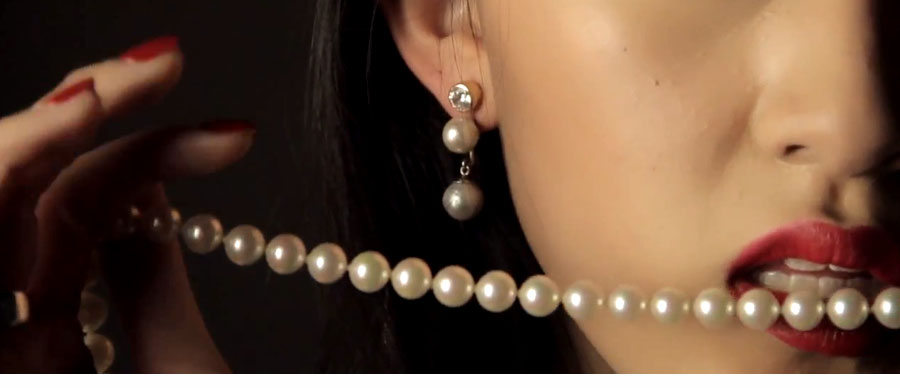August 11th, 2015
Danish archaeologists are scratching their heads over the discovery of 2,000 tiny gold spirals that date back more than 2,900 years.

Unearthed in Boeslunde, Denmark, the mysterious, tightly wound spirals look a lot like the curled fabric ribbons that would decorate a birthday present. Archaeologists from the Danish National Museum and the local Museum Vestsjælland have never seen anything like these spirals before so they can only presume that these pure gold items were part of an elaborate costume.

“The sun was one of the most sacred symbols in the Bronze Age and gold had a special magic,” noted Flemming Kaul, a curator with the National Museum of Denmark. “Maybe the priest-king wore a gold ring on his wrist, and gold spirals on his cloak and his hat, where they — during ritual sun ceremonies — shone like the sun.” Kaul also noted that buried as carefully as they were, the gold spirals could have represented a sacrifice.

The 2,000 specimens were found in one clump. Evidence showed they once occupied a fur-lined box that has long since deteriorated. Some spirals measured 1.18 inches long and all were hammered flat to a thickness of just 0.1mm. The complete collection weighed approximately a half-pound and were dated between 700 BC and 900 BC.

It's not unusual for archaeologists to find Bronze Age gold ornaments in the Boeslunde region. The area has produced some of the largest gold finds from the Bronze Age in Northern Europe, including the recent discovery of four heavy gold arm rings, called oath rings. They each weighed more than a pound.
"It shows that the place had a special significance for the Bronze Age people when they chose to sacrifice several kilos of gold," Kirsten Christensen, curator at Museum Vestsjælland, told the Daily Mail.
Because of the excitement surrounding this latest find, Kaul announced that he and other archaeologists will be continuing their excavations in Boeslunde, a city which lies on the island of Zealand, between mainland Denmark and the tip of Sweden. Boeslunde is about 70 miles southwest of Copenhagen.
Credits: (first, second and fourth) Morten Petersen / Museum Vestsjælland; (third) Flemming Kaul / National Museum of Denmark.

Unearthed in Boeslunde, Denmark, the mysterious, tightly wound spirals look a lot like the curled fabric ribbons that would decorate a birthday present. Archaeologists from the Danish National Museum and the local Museum Vestsjælland have never seen anything like these spirals before so they can only presume that these pure gold items were part of an elaborate costume.

“The sun was one of the most sacred symbols in the Bronze Age and gold had a special magic,” noted Flemming Kaul, a curator with the National Museum of Denmark. “Maybe the priest-king wore a gold ring on his wrist, and gold spirals on his cloak and his hat, where they — during ritual sun ceremonies — shone like the sun.” Kaul also noted that buried as carefully as they were, the gold spirals could have represented a sacrifice.

The 2,000 specimens were found in one clump. Evidence showed they once occupied a fur-lined box that has long since deteriorated. Some spirals measured 1.18 inches long and all were hammered flat to a thickness of just 0.1mm. The complete collection weighed approximately a half-pound and were dated between 700 BC and 900 BC.

It's not unusual for archaeologists to find Bronze Age gold ornaments in the Boeslunde region. The area has produced some of the largest gold finds from the Bronze Age in Northern Europe, including the recent discovery of four heavy gold arm rings, called oath rings. They each weighed more than a pound.
"It shows that the place had a special significance for the Bronze Age people when they chose to sacrifice several kilos of gold," Kirsten Christensen, curator at Museum Vestsjælland, told the Daily Mail.
Because of the excitement surrounding this latest find, Kaul announced that he and other archaeologists will be continuing their excavations in Boeslunde, a city which lies on the island of Zealand, between mainland Denmark and the tip of Sweden. Boeslunde is about 70 miles southwest of Copenhagen.
Credits: (first, second and fourth) Morten Petersen / Museum Vestsjælland; (third) Flemming Kaul / National Museum of Denmark.


